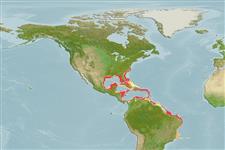Common names from other countries
Environment: milieu / climate zone / depth range / distribution range
Écologie
Récifal; profondeur 1 - 192 m (Ref. 83934). Tropical; 35°N - 21°S, 90°E - 32°E (Ref. 83435)
Distribution
Pays | Zones FAO | Écosystèmes | Occurrences | Introductions
Western Atlantic.
Length at first maturity / Taille / Poids / Âge
Maturity: Lm ? range ? - ? cm Max length : 3.4 cm DL mâle / non sexé; (Ref. 83435)
Maximum depth from Ref. 109264. This species is found in intertidal and offshore coral reefs, particularly on algae, coral, gravel, rock, sand, shells, and sponge habitats (Ref. 83934).
Life cycle and mating behavior
Maturité | Reproduction | Frai | Œufs | Fécondité | Larves
Members of the order Archaeogastropoda are mostly gonochoric and broadcast spawners. Life cycle: Embryos develop into planktonic trocophore larvae and later into juvenile veligers before becoming fully grown adults.
Rodríguez-Sevilla, L., R. Vargas and J. Cortés. 2009. (Ref. 83934)
Statut dans la liste rouge de l'IUCN (Ref. 130435)
statut CITES (Ref. 108899)
Not Evaluated
Not Evaluated
Utilisations par l'homme
| FishSource |
Outils
Plus d'informations
Taille/Âge
Croissance
Longueur-poids
Longueur-longueur
Morphologie
Larves
Abondance
Sources Internet
Estimates based on models
Preferred temperature
(Ref.
115969): 21.1 - 27.5, mean 25.2 (based on 160 cells).
Catégorie de prix
Unknown.
